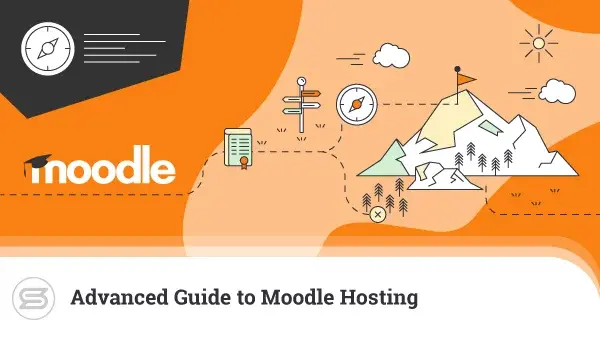According to the official stats, more than 165 thousand websites use Moodle. These sites are registered in 242 countries and are used by over 360 million users.
The figures make Moodle the most popular learning management system (LMS) on the market.
But how did it manage to achieve them?
Quite a few factors have contributed to its success, but its versatility has helped the most. In fact, if it’s set up correctly, it can overcome just about any challenge website owners throw at it.
Today, we’ll demonstrate this flexibility by giving you a few examples of Moodle implementation and showing you how the LMS has helped individuals and organizations of all shapes and sizes achieve their goals.
First, though, a few words about what Moodle is and how it came to be.
What is Moodle?

Moodle is the brainchild of Martin Dougiamas, an Australian software engineer who wanted to create a platform that helps teachers set up online courses and share learning materials with students remotely. At the time, there weren’t many applications of this sort, and although quite a few competing platforms have emerged over the years, Moodle has managed to stay on top of the list in terms of popularity.
How has it done that?
Well, it has a few distinct advantages.
It’s free and open-source.
The core team developing most of the new features in Moodle works for Moodle HQ, an Australian company funded by a network of worldwide partners. However, the open-source community also helps, and the LMS is distributed under the GNU General Public License. In other words, it’s completely free to download, use, redistribute, and edit. Updates are also freely available, and if you need any assistance, you can rely on the community of fans and developers who know everything there is to know about Moodle.
It’s easy to host.
Moodle was written in PHP, and it supports the most popular web server solutions and database management systems. Although it’s easier to deploy it in Linux, you can even run it on a Windows server.
In other words, it will work in most web hosting environments.
As long as the traffic levels are limited, you can run a Moodle site on a shared plan, though you’re probably better off starting with an entry-level VPS that gives you better performance and security as well as unmatched scalability. More often than not, the hosting package comes with an automatic installer that can set Moodle up for you in seconds.
It’s easy to use.
Some might tell you that Moodle isn’t the most user-friendly application out there. However, the truth is even the simplest platform will present an initial learning curve to complete novices. What’s more, the sheer number of projects based on it suggests that Moodle is fairly straightforward to use once you find your bearings.
In addition to this, there’s a ton of tutorials, guides, and videos, so if you ever get stuck, help is rarely more than a couple of clicks away.

It supports the most widely used elearning standards.
Elearning standards turn a collection of learning materials into a coherent online course. With them, the content is neatly organized and made available in a particular order. Students can follow it more easily, and tutors can see how people interact with the materials.
These standards were established a while ago, and their goal is not only to make course management more convenient but also to ensure courses can be moved from one LMS to another.
The most common standard of this kind is called SCORM (or Shareable Content Object Reference Model), and it’s fully supported by Moodle. In addition to this, other industry-specific standards are also available in the LMS.
All these attributes make Moodle a suitable application for an elearning website. However, on their own, they’re not enough to make it such an enormous success. There is one more element of Moodle’s architecture that makes it the go-to solution for so many people.
What Makes Moodle Stand Out From the Crowd?
You may be surprised to learn that the name Moodle is actually an acronym. Initially, it stood for Martin’s Object-Oriented Dynamic Learning Environment, with Martin being Martin Dougiamas, its creator. Over the years, however, “Martin’s” was swapped for “Modular,” and you could say that this is the attribute that sets Moodle apart from its competitors.
No two elearning projects are the same. The requirements vary wildly, and it’s practically impossible to find a single application that can be used in any circumstance. However, thanks to Moodle’s modular architecture, the LMS can be adapted to just about any scenario.
Anyone with sufficient coding skills can create Moodle plugins that expand the system’s functionality and add features that are missing out of the box.
The plugins you install depend on your project’s specific needs. Most people will find what they’re looking for in Moodle’s official plugin directory. At the time of writing, it holds over 1,600 add-ons, with more being added and updated regularly.
If the plugins in the official repository don’t meet your project’s requirements, you can hire a professional developer and have them build a unique extension that fills your personal brief.
The modular architecture and the ability to change the system’s behavior with plugins and other customization options make Moodle an incredibly versatile solution. Let’s take a look at some examples highlighting this versatility.
Examples of Moodle Implementation
We don’t have the time or space to list all the excellent Moodle-powered projects out there. So, instead, we’ll look at examples of how the LMS can be adapted and repurposed to work in a range of environments.
Let’s start with the more obvious implementations.
Moodle in large universities and colleges with extensive online learning programs.

The coronavirus crisis from 2020 showcased Moodle’s ability to substitute traditional lectures and classroom-based lessons with neatly organized online courses that are (in some cases, at least) even more efficient at conveying the required information to the students.
In truth, Moodle didn’t need to prove its worth as an excellent remote learning platform. Universities and colleges had been using it for a while, and both students and teachers knew how good it was. However, after putting it at the center of their curriculum, some higher education institutions realized that Moodle could be more than just an alternative to traditional face-to-face classes and lectures.
For example, CQUniversity, a public university in Australia, used Moodle to improve student retention rates. The teachers there recognized that the analytics data provided by the LMS could be invaluable in determining how learners interact with the courses, what they find easy, and what they struggle with.
CQUniversity had already picked Moodle as an LMS solution, but they decided to expand its functionality with an analytics tool that monitors students’ interaction with the courses, alerts teachers when someone needs assistance, and accumulates data that can help optimize the courses and provide better support in the future.
The tool was written with the help of Catalyst, a Premium Moodle Certified Service Provider. Catalyst’s experts used the Lavarel and React frameworks and integrated the data collection service with the rest of CQUniversity’s internal systems. The result was tons of invaluable data that eventually went on to improve the quality of education.
Moodle in K-12 schools and districts with robust distance learning initiatives.

Implementing Moodle into the K-12 educational system doesn’t sound like the easiest thing in the world. For one, the needs and requirements of students differ with age, and it’s difficult to devise a system that can universally cater to all of them.
The range of methodologies is just as diverse, and some schools struggle to find software that aligns with their philosophy. However, this is rarely a problem once they start using Moodle. Case in point, the Garbí Pere Vergés schools in Spain.
The two schools in Esplugues and Badalona were founded in the 1960s by the Garbi Schools Foundation, and they follow a pedagogical model that differs slightly from the conventional curriculum. Developed by the teacher Pere Vergés, it’s supposed to turn students into proactive citizens that work to improve society and the world around them.
The LMS solution the Pere Vergés schools used before they adopted Moodle was too rigid and couldn’t be adapted to Vergés’s pedagogical approach. At one point, they realized it was not working, so they hired Moodle Premium Certified Partner, 3ipunt.
Using Moodle, they built an elearning platform with a more intuitive interface, automated enrollment, and personalized access privileges for individual users. The Moodle-powered solution helped the schools improve their administrative processes, and crucially, it was ideally suited to Pere Vergés’s methodology.
Moodle in corporations and organizations with in-house training and development programs.

Moodle’s original idea was to be a remote education solution. However, in the modern world, the demand for a robust elearning system goes far beyond schools and universities.
As the work-from-home culture evolves, more and more companies face the challenges of hiring workers remotely. This means that they need to set up an online onboarding and training mechanism that can efficiently supply employees with the information they need with as little hassle as possible. Moodle is the perfect solution for such cases.
It’s not just about people working from home, though. Some large organizations need to train thousands of staff in multiple locations, and they often have trouble finding a single platform that works for everybody.
For example, Network Rail, an enterprise responsible for a large portion of the UK’s railway network, used to have no fewer than ten different LMS solutions for training staff. It’s no surprise that its L&D team was struggling with tracking users and organizing the content. The courses were tricky to follow, and the complex infrastructure frequently led to, among other things, data loss and failed learning objectives.
After careful consideration, Network Rail decided to consolidate its entire elearning infrastructure under a single platform. The L&D team picked Moodle Workplace, a version of the LMS specifically designed for the corporate environment, for the job.
They hired Certified Premium Moodle Partner Titus to build a centralized platform that allowed Network Rail to organize training courses and delegate tasks to local teams. Sub-platforms and user accounts with different access privileges were created, which helped the railway operator track users’ progress and assess their performance. For extra convenience, the entire system was integrated with Network Rail’s enterprise resource planning software.
The scale? Let’s put it this way, Network Rail consists of 14 train operating companies in five separate British regions. In addition to internal training, the Moodle-powered elearning platform also serves around 800 sponsor organizations and partner agencies.
Governments and non-profits using Moodle for elearning and capacity building.

If you see the list of the most popular websites using Moodle according to BuildWith, you’ll notice that many top entries use the .gov top-level domain.
Is this really that surprising?
Government institutions have a range of initiatives, all revolving around online education but having vastly different requirements. In virtually all cases, you need excellent scalability and an application that is powerful and flexible enough to meet what are usually pretty steep criteria.
This is exactly what Andorra, a small European country situated between Spain and France, needed when its government decided to create a country-wide virtual campus. IThinkUPC, a Certified Moodle Partner, was hired to build a centralized platform accessible by all Andorran schools, and the result is a Moodle-powered solution that has been in use for several years now.
On its own, this is quite a serious achievement. However, you have to consider that there are three separate schooling systems in Andorra – one in French, one in Spanish, and one in Andorran. Moodle manages to serve all three simultaneously.
Professional associations and membership organizations using Moodle for continuing education and certification.

The examples we discussed so far show how Moodle can adapt and overcome various challenges. However, although some of the projects above are pretty big, they’re all focused on local companies and organizations. With this one, we’ll see how Moodle works on a truly global scale.
In 2022, The UNESCO Institute for Lifelong Learning (UIL) created a set of training modules designed for literacy educators. The goal was to give teachers across the globe ideas and techniques that would uniform and streamline the learning process among adult students.
The only problem was UIL needed an LMS that would reliably work for people in all corners of the globe. The project would span quite a few territories, so the platform would need to be mobile-friendly and work well with the unstable internet connection in some developing countries. It would also need to be free and easy to host. Moodle was the obvious solution.
By providing an elearning system for acquiring new skills and knowledge, UIL helped educate adult learners whose work commitments would prevent them from attending regular classes. In addition to this, Moodle provided a novice-friendly environment for disseminating information and a range of features that optimize the learning process.
As a result, the project has been described by UIL representatives as “a great success.” The Moodle-powered training modules are used by literacy educators in quite a few countries, including Bangladesh, Cote d’Ivoire, Egypt, and Nigeria, with further expansions expected in the coming years. Ultimately, UIL wants to make the system available to around 100 thousand educators worldwide.
Moodle is more than up to the job of providing a stable platform for the project.
ScalaHosting and Moodle

The great thing about Moodle and its modular architecture is that you can have the functionality you need without adding unnecessary features. On the one hand, this is good news for the budget, and on the other, it means that there are fewer things to slow your site down.
That being said, the add-ons are far from the only factor affecting the performance. For example, a low-quality web hosting service can act as an enormous bottleneck, so it’s essential to pay close attention when picking a provider and plan.
Having helped hundreds of Moodle-powered projects get off the ground, we at ScalaHosting know exactly what both the LMS and its users need. That’s why, if you’re planning to use Moodle, it might not be a bad idea to check out our Moodle hosting solutions.
To guarantee you the best possible performance and reliability, they’re all based on a cloud VPS infrastructure. You get a virtual server with a dedicated IP and guaranteed resources, meaning consistent loading speed and improved security that isn’t affected by outside factors.
And unlike other hosting plans, a VPS can be scaled easily, so it’s a cost-effective solution that can sustain your site’s growth over time.


You’ll manage your VPS through SPanel – an all-in-one server management platform built and designed by ScalaHosting. SPanel has an intuitive graphical user interface, so you don’t need any sysadmin experience to work with it. After your VPS is deployed, you can set up a new user account and use the Softaculous auto-installer to install Moodle in a couple of clicks.
In addition to the ability to immediately start work on your new project, SPanel also gives you all the tools and features you need to control your email and FTP accounts, files, databases, backups, subdomains, DNS records, and many more.
The idea behind SPanel has always been to let site owners with no technical background enjoy the benefits of hosting their projects on a standalone server. Over the years, we’ve added quite a few features that make your life easier, but we’re far from done with it. As an SPanel user, you can actively participate in shaping its development.
There’s a dedicated feature request platform created especially for SPanel admins. Through it, users can request new features and vote for the ones already suggested by others. The tools with the most votes climb their way up the priority list of ScalaHosting’s expert development team and are eventually rolled out to the public.
For us at ScalaHosting, this is a two-birds-with-one-stone situation – on the one hand, we ensure that our customers are happy, and on the other, we guarantee that SPanel is headed in the right direction.
Conclusion
Most people who tell you that Moodle is not suitable for your elearning project either don’t know the platform very well or fail to appreciate its full potential. With the right plugins and expertise, you can adapt Moodle to just about any situation.
What’s more, as some of the examples in our article have shown, Moodle scales well and is suitable for projects of all shapes and sizes, so you don’t need to worry about moving to another platform once your site starts attracting visitors.
All these, among other things, make Moodle the world’s top learning management system.
FAQ
What can Moodle be used for?
Moodle is an open-source learning management system that can be used as a platform for a range of elearning projects. It’s suitable for anything from online education systems implemented in schools and universities, through corporate training and onboarding procedures, to government initiatives.
How effective is Moodle?
Throughout the years, quite a few studies have shown that, once they get to know the platform, both students and teachers find Moodle effective as an online education tool. However, the biggest testament to the app’s abilities was showcased during the COVID-19 pandemic when hundreds of thousands of schools and universities had to switch to remote classes and chose to use Moodle for elearning purposes. The platform’s versatility meant minimal impact on the quality of education.
Is Moodle an example of an LMS?
Yes, Moodle is an open-source learning management system that facilitates online classes and lectures for projects of all shapes and sizes. Its modular architecture allows developers and the open-source community to build plugins and add-ons that expand the platform’s functionality and adapt it to a broad range of different projects.



